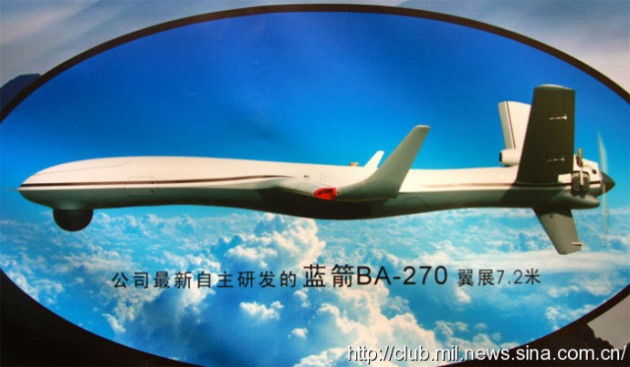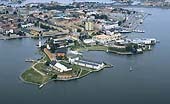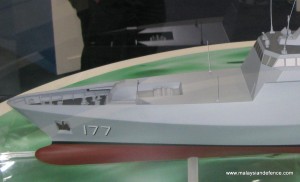
This places an emphasis on flexibility, ease of use for systems often operated by police and Paramilitary organisations and affordability across a range of platform and sensor types. Ships maintaining a presence at sea have been the traditional means of securing the littoral using a range of Offshore Patrol Vessels (OPV) and smaller craft although the demands of littoral surveillance and the distances required to secure and patrol offshore resources has seen the size and complexity of vessels increase in recent years.
China’s maritime claims have become very expansive of late with the country claiming great swathes of the South China Sea with a building programme in place to support those efforts. The China Marine Surveillance (CMS) agency brought two new 3000 ton patrol vessels into service in early November. The Haijian 137 is currently operating in the East China Sea with its Haijian 110 sister ship in the Yellow Sea. The largest ship built for the CMS is the 128.6m 5,418-ton Haixun01 which has an unrefueled range of 10,000 nautical miles (18,520 km). Until now the only large vessels in CMS service have been only retired Peoples Liberation Army Navy (PLAN) vessels have been transferred to the CMS. One of the most recent is the demilitarised Luda Type 051 class destroyer the Nanjing (131) which retired from PLAN service in September. The CMS have 36 ocean going vessels currently under construction.
China is not the only country building up its littoral capabilities. The Indian Coast Guard (ICG) continues to balloon. Four of twelve Griffon Hoverworks air cushion vehicles are in service at various locations around the country including the Sunderbans tidal mangrove forest. Twenty new Fast Patrol Vessels being built at Cochin Shipyard Ltd for the ICG, are equipped with Northrop Grumman’s Sperry Marine VisionMaster, Total Watch systems, reflecting the complexity of India’s requirements. Another class of Coast Guard vessels is the 50m, 300 tonne Inshore Patrol Vessel (IPV) which has a 1500nm range and a maximum speed of 34kts with a total of eight IPVs ordered from Garden Reach Shipbuilders and Engineers.
The Philippines Coast Guard currently has nine operational ships. It is acquiring a single 82m high endurance ship and four 24m patrol boats from France in a €90 million ($116 million) due to be delivered in 2014 with the shipyard thought to be CMN. The Philippines Coast Guard have indicated that they expect to also take delivery of ten 40m patrol boats from Japan in the second half of 2013.
Vietnam is also building up its naval and maritime forces with the Vietnam Marine Police Force recently launching a 2400 tonne, 90M Damen 9014 design Offshore Patrol Vessel with the ship entering sea trials ready for entry into service in early 2013.
Solutions developed out side the region have often found a role there. Littoral patrol designs are regularly being developed,
far more regularly than large ocean going warships.
Finland recently chose Marine Alutech to develop the Watercat M18 for inshore roles for example landing troops to deal with pirates. Finland is taking delivery of twelve in a $41 million deal from 2014 to 2016.
The US Coast Guard has been the lead for a number of designs. Its latest is the Offshore Patrol Cutter (OPC) requirement designed to replace the ageing Medium Endurance Cutters with a requirement for 11 OPCs with as many as 25 ultimately required with Bath Iron Works, Bollinger, Huntingdon Ingalls, Marinette Marine, Nassco, Vigor Shipyards and VT Halter Marine competing for the contract.
France’s Direction générale de l’armement (DGA) has recently begun the process to replace its P400 Large Patrol Craft built by CMN in the 1980s. The new programme or Batiment Multi Mission (B2M) will initially see three B2Ms deployed in around the Caribbean waters of French Guyana in around 2014 and tasked with protecting the space centre at Korou and oil fields recently discovered in the area. Next, larger B2Ms will be deployed at French territory in the Pacific and Indian Oceans. Another French OPV with a variety of roles is the DCNS Gowind class, a design which can also support combat roles having been chosen for the six second-generation patrol vessels for the Royal Malaysian Navy.
Sensors and networks
A platform at sea is in many ways an optimal solution but not one that provides persistent surveillance, limited by the ship’s endurance and the range of its sensors that relatively small platforms can carry. Integrated coastal and littoral surveillance systems matched to command and control (C2) hubs in contrast, offer a persistent fixed presence however, these surveillance systems don’t have it easy with the environment making target discrimination and detection difficult in heavy rain, high-sea state conditions and other clutter associated with the region.
The biggest coastal surveillance programme in the region is India’s Coastal Surveillance Network, operated by the Indian Coast Guard with 46 surveillance stations; 36 locations on the mainland coast, six locations in the Lakshadweep and Minicoy Islands and four in the Andaman and Nicobar Islands, all based on co-located lighthouses. Each installation is designed to cover an area of 25 nautical miles around the site using radar and EO/IR sensors and focused on the area of high sensitivity and traffic density. They are also able to interrogate class ‘A’ and ‘B’ Automatic Identification System (AIS) transponders sourced from Saab and Elcome Marine Services in a $22 million deal signed in November 2010. These were rolled out in the first stage by Bharat Electronics Ltd in a Rs 601.75 crore programme which is due to complete in March. The next stage will see existing stations backfilled with additional surveillance equipment and a
further 38 coastal surveillance radar plus eight Mobile Surveillance Systems added in a Rs 1,000 crore deal.
In addition to terrestrial sensors, countries can also enlist the support of space based assets. Astrium launched its OceanWay solution in October which combines satellite-based AIS and GO-3S for video from space via an Earth-observation satellite system generating imagery at a rate of 25 images per second. Another Astrium effort has been the launch last year of the Astrium Surrey Satellite Technology Limited exactView-1 satellite which also covers AIS and was developed and launched for customers; COM DEV International Ltd and HISDESAT Servicios Estratégicos S.A.
The Brunei National Coastal Surveillance System (NCSS), first formed in February 2010 is also undergoing a new initiative to boost capabilities after an initial period of development which focused on integrating existing organisations and capabilities.
Other AIS efforts include Northrop Grumman Information Systems who completed delivery of the USCG led Nationwide AIS contract worth $12 billion ensuring AIS coverage across the US mainland and its overseas territories.
ESRI UK has supplied the European Union Naval Force (EUNAVFOR) Operation Headquarters tasked with the EU Naval Force’s Mission Network in support of Counter-Piracy operations around the Horn of Africa. The company have delivered the Recognised Maritime Picture based on its geographic information system software including ArcGIS for Server version 2.5 with a server on each ship and ArcGIS Viewer for Flex on board each ship with satcom based updates between ships.
Indra has delivered a coastal surveillance system for use on Spain’s coast and has also been contracted to supply a solution for Hong Kong and the islands under its administration. It is also leading the European Union’s Perseus project to develop a single integrated system from multiple national surveillance systems.
Kylmar’s CT1600 Coastal Surveillance System is in service with Egypt, which is the system’s largest customer. The CT1600 consists of a thermal and day system with a laser range finder which can deliver an accurate position of a ship within just 5m at a range of 20km. Egypt has developed a network of these systems along its Red Sea coast. One element of the Indian coastal surveillance system is the 46 ARGC-2400 cameras electro-optic cameras sourced from Canada’s Obzerv Technologies which are used to classify and identify targets.
Sweden has tasked ITT Exelis with surveillance of its coastline with its SABER 2020, integrated coastal based around the LCR-2020 radar with all-weather coverage of air targets with a range of electronic counter-countermeasures. Indonesian firm Radar and Communications Systems have developed a new shelter and vehicle mounted 96km range, S-band LPI Portable Coastal Radar. Development is due to complete in 2013. Indonesia is already being protected by Kelvin Hughes S-Band SharpEye solid state radar sensors in Maluku province and Papua province, working with local firms. GEM Elettronica plan to release a new X-band three-dimensional naval surveillance radar in 2013, for navigation and general surveillance with a view for integration on offshore patrol vessels of about 500 tonnes.
Raytheon have developed a number of coastal and maritime surveillance radars. It worked with Canada on the Next Generation High Frequency Surface Wave Radar (HFSWR) Technology Demonstration Programmes, designed to cover the country’s 200 nautical mile Exclusive Economic Zone. The company’s SeaVue eXpanded Mission Capability was ordered by Morocco in 2011 for coastal surveillance and is deployed on aircraft with users in the region including Australia, Japan, Pakistan, Taiwan and Thailand. The SPEXER 2000 radar, one of Cassidian’s latest development is an Active Electronically Scanning Array (AESA) design with an instrumented range of 21.6 NM (40 km) coupled with high Doppler and velocity resolution.
Elbit Security Systems is currently providing the surveillance systems for the port of Haifa including typical maritime traffic as well as the chemical terminal. The systems fuses information from variety of perimeter and maritime sources in a central C2 hub. In Asia, the company has announced an Asian contract for maritime surveillance for the using Micro CoMPASS and DCoMPASS for fixed, airborne and seaborne platforms in a $20 million deal.
Bulgaria tapped Atlas Elektronik in 2011 to provide an integrated coastal surveillance systems covering the country’s 350km of coastline and run by the Border Police. This package comprised a surface radar, signal processing, multi-sensor tracking, including AIS and CCTV, communications, system management and recording & replay based using SEATRACK. The system is comprises twelve remote sites each with radar, AIS transponders, daylight and IR-Cameras and weather stations supplemented by two mobile ground units and twelve Border Police Boats each with its own ISR package.
Airborne platforms
Maritime and land based surveillance and patrol platforms are enhanced by airborne platforms with the requirements eschewing large highly capable platforms such as the P-3 Orion and instead preferring smaller, lighter and more affordable platforms in which still highly capable sensor and mission systems can still be integrated.
The first of six Viking Air DHC-6 Twin Otter Series 400 maritime surveillance aircraft have been delivered to Vietnam for coastal surveillance via Canada’s Pacific Sky Aviation
In Australia, Cobham is supplying Customs and Border Protection Service with the Sentinel aerial maritime surveillance programme, which has been extended to 2021. Beginning in 1995 the contract is a service contract covering 15000 flight hours per year which equates to roughly 2500 mission using Bombardier Dash 8 maritime patrol aircraft.
Indra’s latest airborne coastal surveillance systems is the Maritime Light Surveillance System (MLSS) launched at Farnborough. based on the P2006T MRI, a high wing light twin-engined, aircraft it has been equipped with the Selex Galileo Seaspray 5000E AESA surveillance radar and Indra’s ISIS mission system and is designed for use at up to 150nm from the coast.
The HC-144A Ocean Sentry, based on the Airbus Military CN235, is the US Coast Guard solution for airborne surveillance. The fourteenth aircraft has recently been taken delivery of, with a final requirement for 36 aircraft having been established.
India’s Coast Guard operates the Do-228 maritime patrol aircraft with well over 100 delivered to date. Produced by the Transport Aircraft Division of Hindustan. Aeronautics Limited, it is tasked with maritime surveillance as its primary role but can also be re-roled to troop transport, air-drop, search-and-rescue, casualty evacuation and cargo missions.





